Question:
The demand function for a good is given by:
The supply function is:
Where:
- is the price per unit (in dollars)
- is the quantity demanded or supplied
In the past, no tax was imposed on this good.
Now, a 10% value-based tax is levied on consumers (i.e., the price paid by consumers is 10% higher than what producers receive).
Calculate the equilibrium quantity before and after the tax is imposed.
✅ Solution
Step 1: Initial Equilibrium (No Tax)
Set demand equal to supply:
Solve for :
Substitute back to find equilibrium quantity:
🔹 Equilibrium Price (No Tax): $20
🔹 Equilibrium Quantity (No Tax): 60 units
Step 2: New Equilibrium with 10% Tax on Consumers
Let:
- = price received by sellers (net price)
- = price paid by consumers
We adjust the demand function because consumers now face a higher price:
Supply remains unchanged:
Set to find new equilibrium:
Solve:
Now find consumer price and new quantity:
🎯 Final Answer
| Before Tax | After Tax | |
|---|---|---|
| Seller Price | $20.00 | $19.05 |
| Consumer Price | $20.00 | $20.96 |
| Equilibrium Quantity | 60 units | 58.1 units |
📚 Interpretation
After the 10% ad valorem tax on consumers:
- Quantity traded in the market decreases slightly (from 60 → 58.1),
- The burden is shared: producers receive less, and consumers pay more.
This demonstrates how taxes distort markets, even if demand and supply are both linear.

